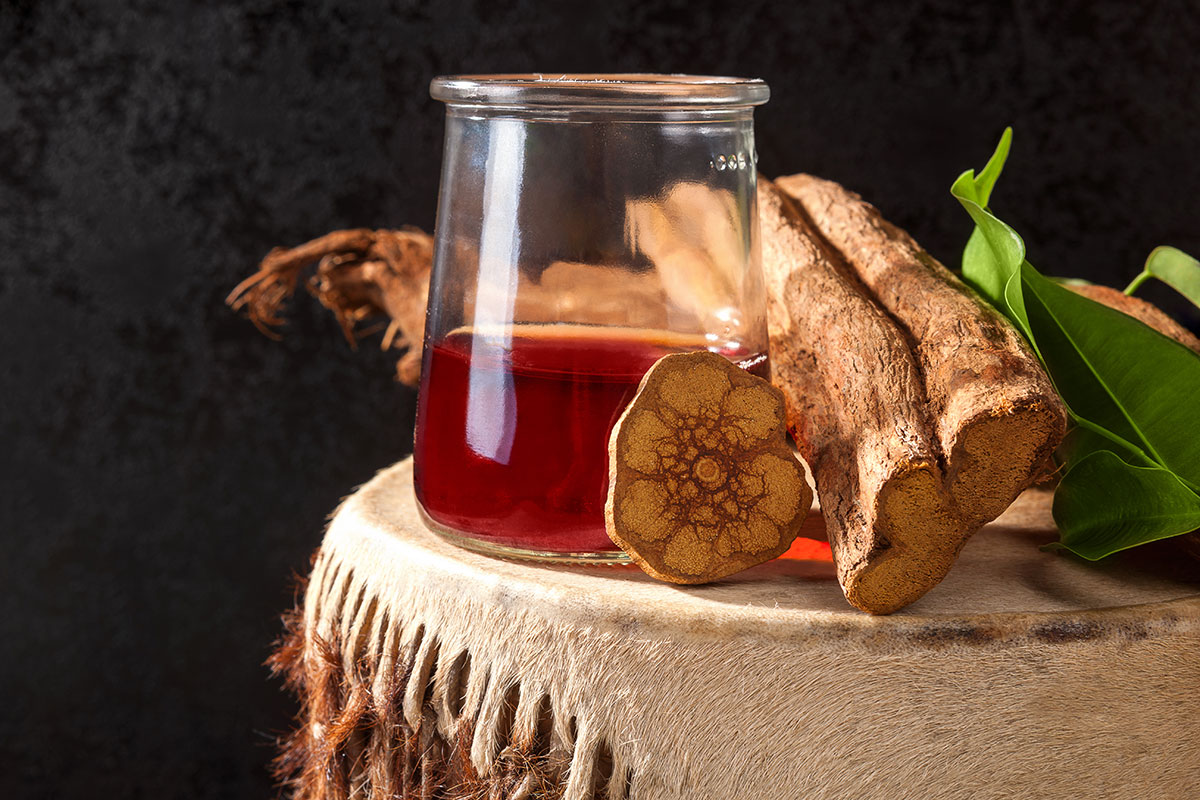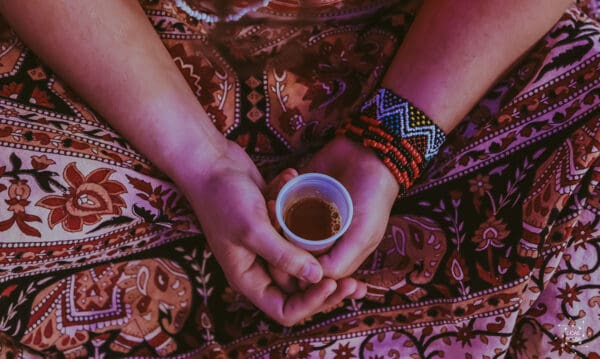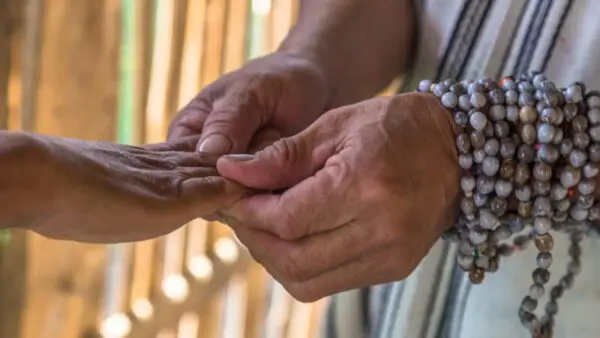Medical Editor: Dr. Benjamin Malcolm, PharmD, MPH, BCPP
What is ayahuasca?
Ayahuasca is a psychedelic tea or brew that originates from the traditions of tribes in the Amazon basin and Central America. Research has shown that ayahuasca has the potential to treat depression, PTSD, addiction, and more. This ancient healing tradition is currently going through a revival where more and more westerners are drinking ayahuasca in hopes of improved mental and/or physical health.
Ayahuasca is typically a decoction of the ayahuasca vine (banisteriopsis caapi) and chacruna leaf (psychotria viridis). These two plants do not necessarily produce a strong hallucinogenic effect when ingested separately. In combination, harmala alkaloids in the vine inhibit a gut enzyme known as monoamine oxidase from metabolizing the dimethyltryptamine (DMT) in the chacruna plant. The tea induces an intense perceptual, mental, physical and emotional experience which lasts around 4-8 hours.
Is ayahuasca legal?
The answer is complicated. This webpage includes a look at the legal status of ayahuasca, country by country.
Ayahuasca is illegal in many countries because it contains the psychedelic, DMT. In the United States, ayahuasca is federally illegal as a Schedule 1 controlled substance. However, the Religious Freedom and Restoration Act (RFRA) in 1993 set a precedent that religious organizations and churches for whom ayahuasca is a sacrament may be exempt from legal recourse for serving the brew at their ceremonies. These exemptions are handled on a case-by-case basis; therefore, saying that you drink ayahuasca as a religious practice and/or belong to a church does not mean you are exempt from the laws prohibiting ayahuasca in the US.
Ayahuasca is legal under cultural patrimony in Peru, and is served in many countries in south and central America that have a legal gray area. Some cities and states in the US and countries such as Portugal have decriminalized either all drugs or at least plant-based psychedelics. However, decriminalization is not the same thing as legalization and local law does not supersede federal law.
Who should not take ayahuasca?
People who are affected by or have family histories of psychotic or bipolar illnesses should generally avoid use of psychedelics. Many facilitators and retreat centers advise that ayahuasca is contraindicated with borderline personality disorder, bipolar disorder or schizophrenia. One case study advised caution around ayahuasca use for individuals with generalized anxiety disorder.
Some therapists and medical professionals advise that a person with post-traumatic stress disorder (PTSD) should proceed carefully with ayahuasca and other psychedelics, as the experience could be re-traumatizing. However, many people with PTSD have reported profound changes in their life which they attribute to ayahuasca healing. Taking proper precautions, spending time to prepare, working with a skilled and experienced facilitator and integrating the experience afterward can reduce the risk of adverse experiences.
Ayahuasca may not be safe for people with heart or liver problems, kidney disorders, high blood pressure, and diabetes. Someone with a serious cardiovascular disorder may be harmed by the increase in blood pressure that ayahuasca can cause.
Certain medications are unsafe to combine with ayahuasca, described in full here.
Can you drink ayahuasca on your period?
Some indigenous cultures who use ayahuasca say that people who are menstruating should not come to the ceremony. This has been challenged by other people in the community, especially westerners, and has been critiqued as a patriarchal rule.
This is certainly a complex issue, and you will find that different ayahuasca circles and facilitators follow different guidelines and teachings.
Medically, there is no known risk to drinking ayahuasca while one is menstruating. A person on their period may feel more intense emotions and physical sensations and may be more energetically open; for this reason, some may go lighter on their dose of ayahuasca, or the server may offer a specific blessing to their cup before they drink.
With the increasing interest and use of ayahuasca in the western world, the prohibition against drinking ayahuasca while menstruating presents complications. For instance, if someone is taking two weeks off of work to fly down to Peru and attend an ayahuasca retreat, they may not be able to control when they get their period. That being said, traditions can have their merits and it is not necessarily right to change an ancient convention just to fit in with what is convenient for the modern world. Each situation is different and should be evaluated on a case-by-case basis, in conversation with one’s facilitator or retreat center.
What can you eat before ayahuasca?
Preparing the body and mind for the ayahuasca experience is something that ideally begins long before the day of the ceremony. While some ayahuasca facilitators advise a very strict diet for two weeks or more prior, others are more lax in their restrictions.
In general, taking antidepressants (e.g. SSRIs), amphetamines, and other drugs before or during an ayahuasca ceremony can be dangerous, even lethal. Follow the instructions of the person organizing the ceremony. If they aren’t providing clear guidelines for the preparatory diet or medications to avoid, this is a red flag.
Common recommendations are to avoid caffeine, alcohol, cacao, spicy foods, dairy products, red meat, and refined sugar for at least a week leading up to the ceremony. Many facilitators say that pork, cannabis, recreational drugs, and sexual activity should be avoided for two weeks before and after ayahuasca.
Tyramine is an amino acid present in many foods such as aged cheese, yogurt, fermented foods, yeast, some legumes, as well as ripened fruits and vegetables. Excessive consumption of these foods around the time of an ayahuasca experience could lead to medical complications such as hypertensive crises or blood pressures so high that there is a risk of adverse events like a stroke. From a medical perspective, avoiding foods that are rich in tyramine content for a day before and after is sufficient to avoid risks.
In general, eating a simple, natural organic diet and avoiding salt, spices, tyramine-containing and other prohibited foods will serve as great preparation for ayahuasca. It’s OK to eat organic, free-range chicken and wild-caught fish in the days before a journey. Whole grains such as brown rice, quinoa, amaranth, and lentils are a great option. The diet is intended to cleanse the person physically, mentally, emotionally, energetically and spiritually in preparation for the ceremony. Being intentional with the diet may help provide a more optimal experience. The more conscious preparation for the experience, the more effective ayahuasca may be able to work.
How often should people drink ayahuasca?
How often to drink ayahuasca is best established on a case by case basis, in consultation with experienced facilitators and one’s own inner wisdom.
It is common on ayahuasca retreats to drink two or three evenings in a row, or have several ceremonies over the course of the retreat. Some people are working on deep traumas and internal emotional and spiritual processes and so they may go through a period where they sit in ceremony a lot. However, clinical studies of ayahuasca use have shown rapid antidepressant effects with even a single dose.
Groups that use ayahuasca as part of their spiritual or religious practice may gather as often as biweekly to use the sacrament. These groups have been followed over time for up to a few years without any evidence that regular drinking is harmful to mental or physical function.
Ayahuasca is not known to be addictive and persons do not crave ayahuasca, even if they have sat in several ceremonies previously. However, in some, there can be an obsession with use that is perhaps more accurately a form of spiritual bypassing or attempt at living closer to the spiritual world ayahuasca opens as opposed to addiction.
The community that some people find around ayahuasca may be part of the reason that they drink as much as they do. Some people drink a lot of ayahuasca and then slow down, take a break, or stop when a certain amount of healing, spiritual progress, or other variable is reached. Some people stop when ayahuasca tells them to stop or it simply feels right. Some people slow down and then return to ceremony intermittently or sporadically for maintenance-type work. Some persons continue to overuse and may succumb to delusional belief systems due to excessive openness or develop a dependence on ayahuasca to ‘feel spiritual’.
In general, it is ultimately up to the individual to decide how often they should sit in ceremony.
What are the long-term effects of ayahuasca?
The long-term effects are a function of several factors, including the integrity and experience of the curandero or facilitator, the intention the person brings to the work, and their commitment to integration following the journey.
An analysis of 28 studies on ayahuasca showed that the brew has antidepressant and anti-addictive potentials. Although current research indicates that healthy volunteers do not tend to experience long-term adverse side-effects and adopt behaviors that may be preventative of poor health (e.g. reduced alcohol consumption), more studies are needed. At this time there is no evidence of detrimental effects associated with long-term use.







